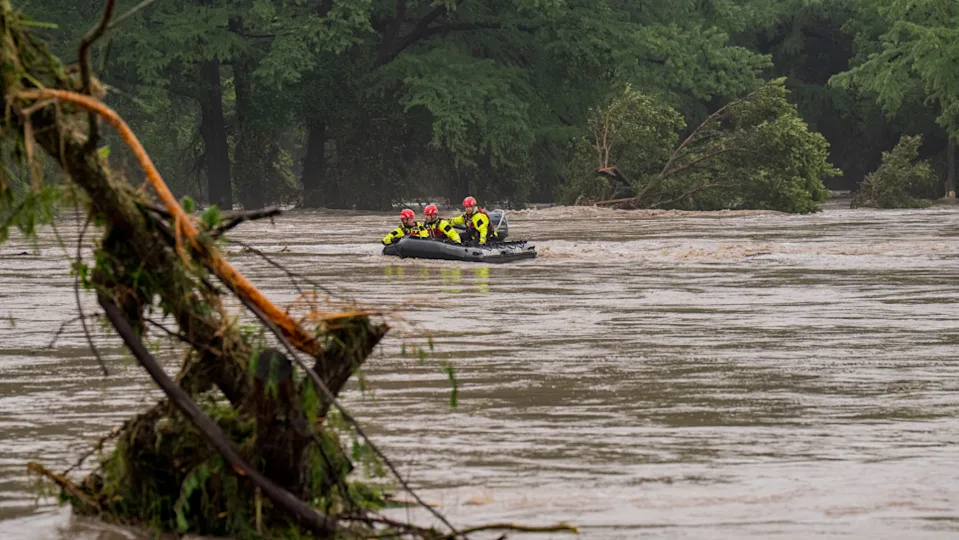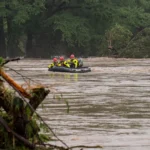
Sudden Deluge Strikes Before Dawn
In the early hours of July 4, south-central Texas, part of the scenic Hill Country northwest of San Antonio, was hit by a catastrophic flash flood when intense thunderstorms dropped up to 10 inches (250 mm) of rain in mere hours. The swollen Guadalupe River surged more than 22 feet in about two hours, reaching an unprecedented 26–29 feet in some areas, washing away roads, cabins, vehicles, and private homes in towns like Hunt, Ingram, Kerrville, and Comfort.
Initial Casualty Reports and Escalating Toll
Authorities initially reported 13 confirmed fatalities on Friday as rescue operations continued. That number later rose to at least 24 deaths across Kerr and Kendall counties by Friday night, with hundreds still reported missing or unaccounted for. The victims included both adults and children, as clarified by Lieutenant Governor Dan Patrick: “Some are adults, some are children.”
Camp Mystic in Crisis
The disaster’s most heartrending dimension unfolded at Camp Mystic, a century-old Christian girls’ summer camp on the banks of the Guadalupe River hosting around 750 campers. Scores of cabins, especially those hosting younger girls near the riverbank, were obliterated or swept away; roads in and out of the camp were impassable. At one press conference, Lt. Gov. Patrick disclosed that about 23 girls remained unaccounted for. The camp’s email to families emphasized that only if a camper’s parent had not been contacted was her daughter still missing, indicating urgent ongoing efforts.
Desperate Rescue Efforts
A massive emergency response was mobilized, deploying approximately 500 ground personnel, 14 helicopters, 12 drones, nine rescue teams, and additional boats from the U.S. Coast Guard and National Guard. By Friday night, officials reported that 237 people had been rescued, including 167 via helicopter. Rescues included people stranded in trees, swept from their homes and cabins; in one case, a victim was hauled by helicopter from atop a tree.
Shocked Locals Recall the Fury
Residents in Ingram and Kerrville spoke of waking to thunder and heavy rain before being caught off-guard by a “pitch-black wall of death”, the water ascending fast and with terrifying force. In one family’s account, a mother and her son clung to a tree for over an hour, while her partner and dog were swept away before being rescued.
Warning Systems Were Overwhelmed
Despite the National Weather Service issuing flash flood emergencies and alerts, many communities reported receiving no official emergency warning. Kerr County Judge Rob Kelly admitted there was “no warning system,” saying, “Rest assured, no one knew this flood was coming… none whatsoever.”
Climatic and Geological Context
Experts noted the area’s thin soil and rocky terrain, characteristic of central Texas’s so-called “flash-flood alley”, increase runoff and intensify flood impact. In this instance, locally heavy rainfall, driven partly by the remnants of Tropical Storm Barry, overwhelmed the landscape with historically damaging results.
Gov and Fed Aid Roll Out
Governor Greg Abbott declared a disaster for Kerr, Ingram, Hunt and other affected counties, mobilizing state, National Guard, and federal resources, including FEMA and the U.S. Coast Guard. Abbott, calling the flood an “extraordinary catastrophe”, pledged relentless rescue operations and warned more flooding could follow with additional rain.
Camp Mystic’s Legacy and Losses
Camp Mystic, founded in 1926, had been nearing its 100th anniversary and is deeply woven into the Hill Country’s cultural tapestry. At least two fatalities were confirmed at the camp, one being a camp director, while dozens of girls from the camp are still missing, some likely stranded in flooded cabins or treetops.
Global Concern and Human Stories
The plight of the missing girls has resonated widely. Parents anxiously posted photos and pleas in local forums, while public figures, including MLB star Alex Bregman, have appealed for help. The scale of the flooding, 12 inches overnight, more than a year’s average rainfall, underscored the ferocity of the event.
Aftermath and Ongoing Threats
As of early July 5, the death toll continues to climb, with at least 27 fatalities confirmed in the broader flood event. Authorities emphasize that missing persons may not be fatalities, they could simply lack communication. Additional rainfall and flash flood warnings remain in place for regions between San Antonio and Waco, prolonging risks and complicating rescue efforts.
Lessons for the Future
This tragedy starkly highlights vulnerabilities in warning systems, flash flood preparedness, and infrastructure resilience in fast-changing weather. The combination of climate change, terrain, and the area’s popularity as a camping and recreation destination demands a re-evaluation of emergency response and environmental planning.
A Community United in Loss and Hope
As search-and-rescue efforts push forward, Hill Country communities stand resilient, bolstered by mutual aid, faith, and determined emergency response. The fate of the missing girls hangs in the balance, but the outpouring of support, from local churches to national agencies, embodies hope amid heartbreak. For residents and families, the message is clear: stay alert, stay prepared, and stay together.




































Leave a Reply